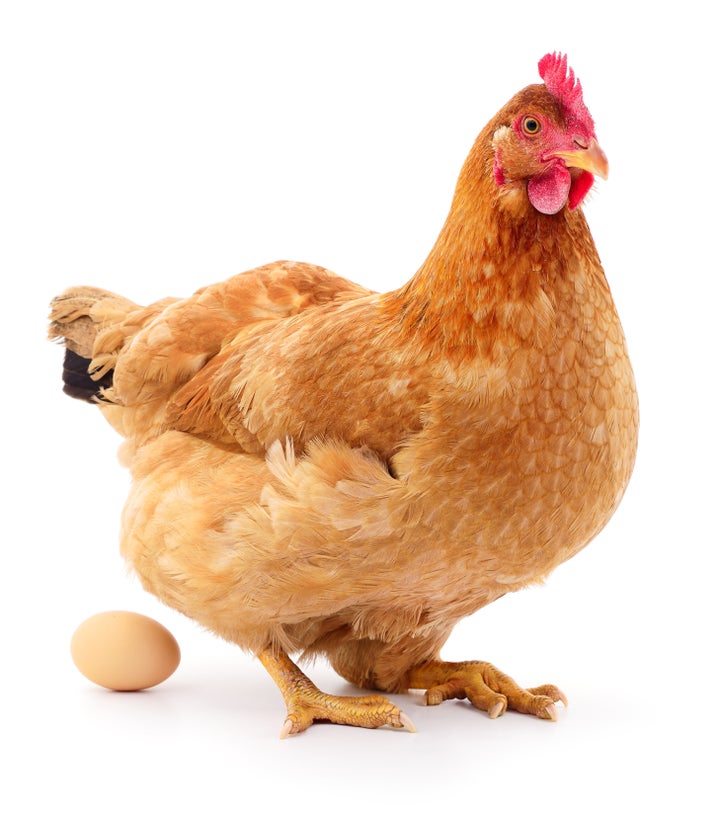
Do we eat the chickens that lay our eggs? It’s not a dumb question to ask, and the answer might surprise you.
Unless you’ve raised backyard chickens, we’re willing to bet that the average egg consumer doesn’t know that hens stop laying eggs pretty early on in their lives. Chickens live eight years on average, but hens only productively lay eggs in the first two, maybe three years of their lives. And on the commercial level, it’s closer to two years, and sometimes less.
When hens are productively laying eggs, they’ll lay one egg about every 22 hours. As they get older, this becomes less and less frequent. So when you’re a commercial egg farmer, what do you do with the thousands of hens taking up barn space that aren’t really laying eggs anymore?
Jesse Laflamme, CEO of Pete and Gerry’s Organic Eggs (which raises certified humane eggs from small family farms), explained one way that non-humane egg factories deal with the situation.
“What typically happens is they just gas them with CO2, and asphyxiate them. Then they put them into trucks or dumpsters and they’re landfilled, or they render them,” Laflamme told HuffPost. Laflamme said he couldn’t speak to what exactly happens when the chickens are rendered, but that it’s basically “where they turn the hens into oils and other products that are used in various industries.”
This sounds horrific, but Matt O’Hayer, CEO of Vital Farms (which also raises certified humane eggs) and a long-time vegetarian, said he thinks it’s actually one of the more humane ways currently used to deal with this problem. “If you euthanize them on the farm at night, their life is over quickly,” he said.
Another common solution to the problem of “spent hens,” as they’re called in the industry, is to turn them into pet food. O’Hayer says it’s the most common solution, but not a very humane one.
“If you send them to a pet food plant, which is the biggest use of spent hens, they pack them into crates and ship them in trucks hundreds of miles. It’s stressful for them and it’s not very humane,” O’Hayer said.
But O’Hayer said that this is sometimes the solution for his hens at Vital Farms. “Most of our flocks are sold live by our family farmers to local families or to pet food companies,” he explained. “In the rare instance in which a flock must be depopulated on-farm, contractors are employed by the farmer, who typically use CO2, which is currently the most humane method.”
Non-humane certified large-scale egg factories contacted by HuffPost were not willing to comment on these practices. They can house anywhere from 250,000 to 500,000 egg-laying hens at once, according to Laflamme. The hens are all generally the same age, so they typically stop laying around the same time. Essentially, when the chickens no longer lay eggs, the farmers are out of business until they can get new hens.
And then the process repeats.
Not all egg farmers engage in the practice of gassing and dumping their spent hens. Pete and Gerry’s Organic Eggs outlines on their website how they treat the end of laying and life for their hens. Pete and Gerry’s process their egg-laying hens for meat once they slow down their egg production, which is rare. For many, this solution feels more ethical than euthanizing and dumping.
The reason it’s not common to eat spent hens is two-fold.
First, egg-laying hens aren’t quite as tender as hens raised for meat. That’s because they’re older and their muscles have done a lot more work. They taste gamier and their meat is tougher. According to O’Hayer, a chicken that’s raised for meat is only 40 days old, where an egg-laying chicken is on average around 560 days old. And he said that between 40-56 days there’s a huge difference in flavor, so tack on an additional 500 and the difference is even greater.
Second, egg-laying hens and broiler hens (another term for meat hens) don’t taste like the same bird. While they both come from the same chicken breed, throughout the years they’ve been bred to either be more productive egg layers, or to produce more meat. “The broiler hen vs. egg-laying hen is a crazy agricultural thing that has happened over the last 100 years,” said Laflamme. In fact, the meat from Pete and Gerry’s birds doesn’t make it to the supermarket shelves because it’s sold at ethnic food markets, where the flavor of a gamier bird is desired.
So while you’re probably not eating the chickens that laid your eggs, chances are those chickens didn’t exactly roam green pastures and die a natural death in their final days.